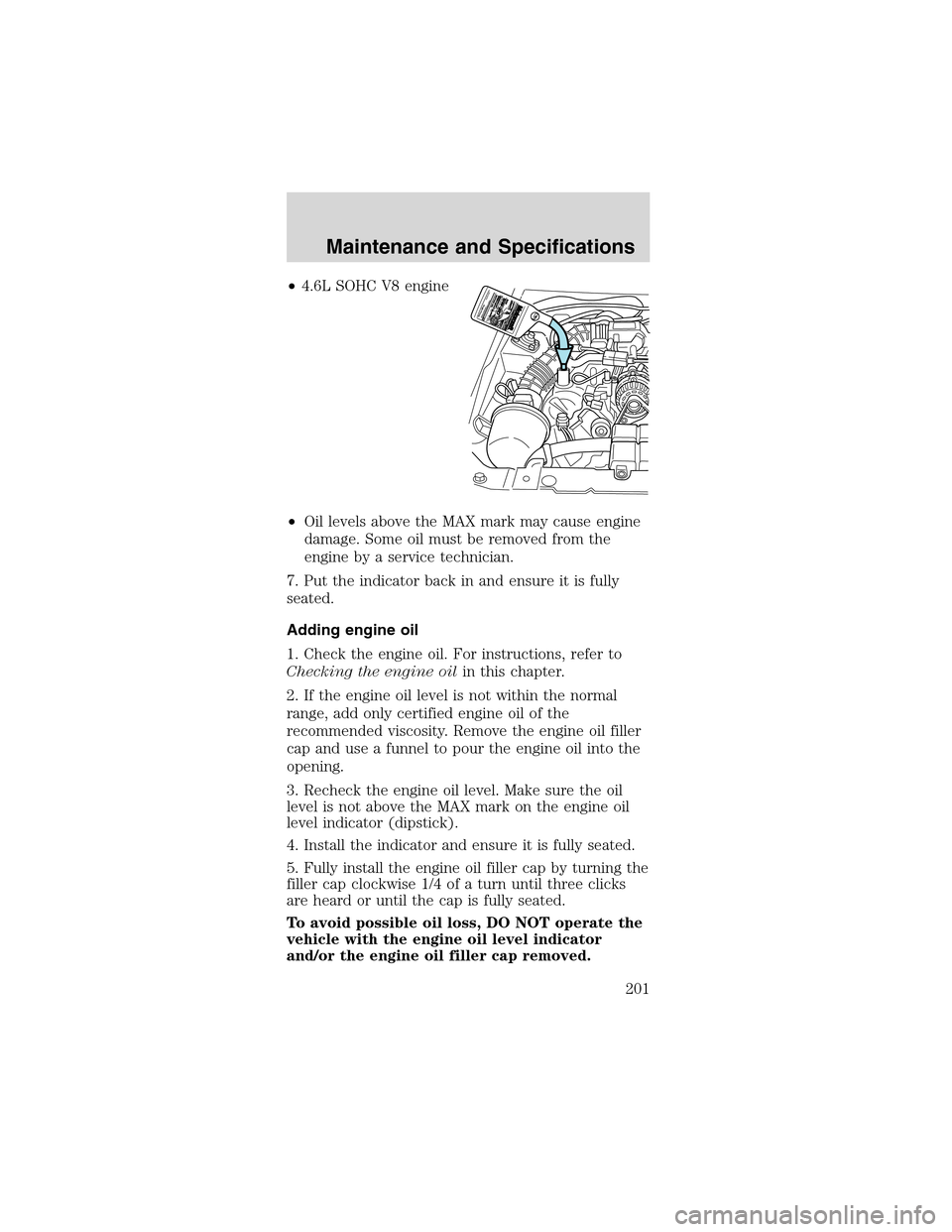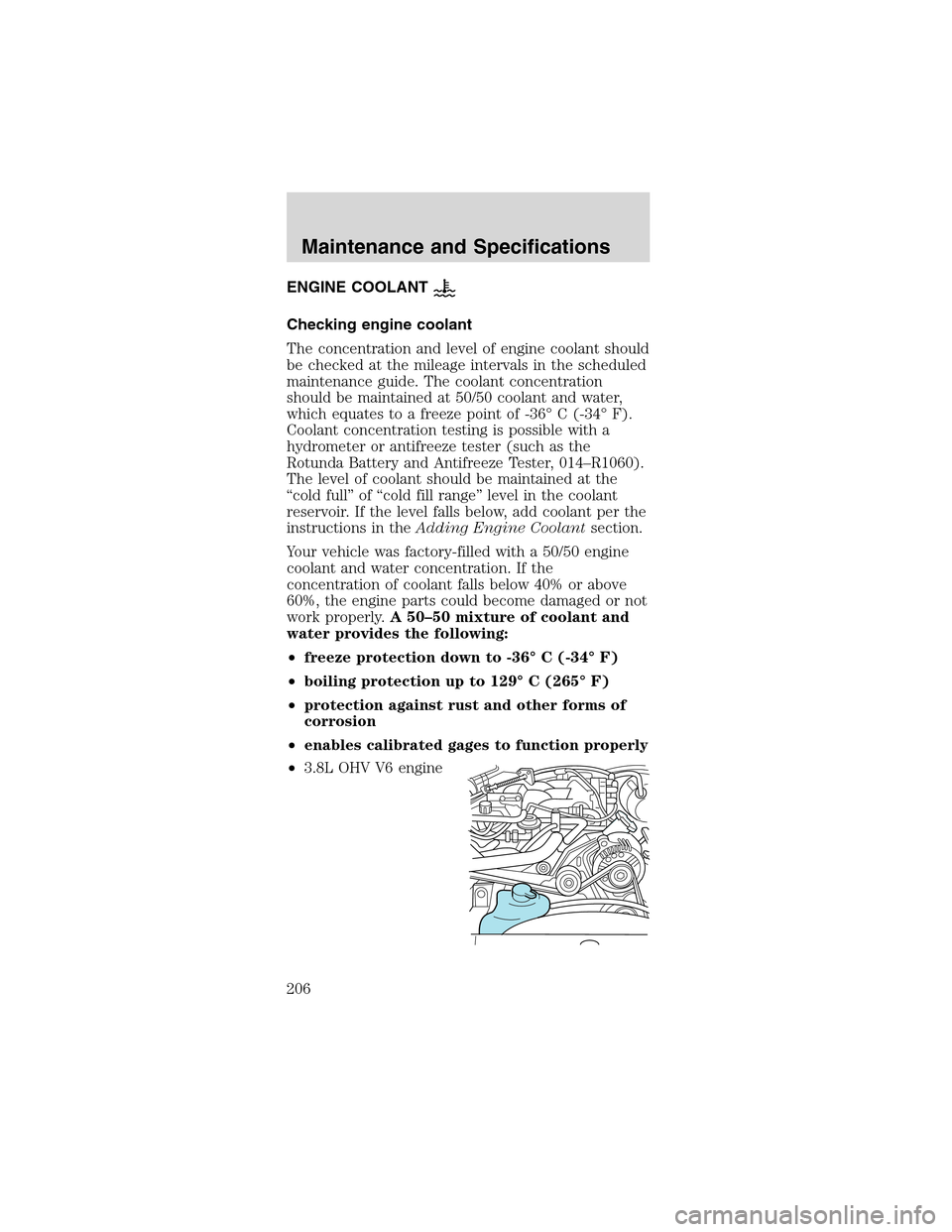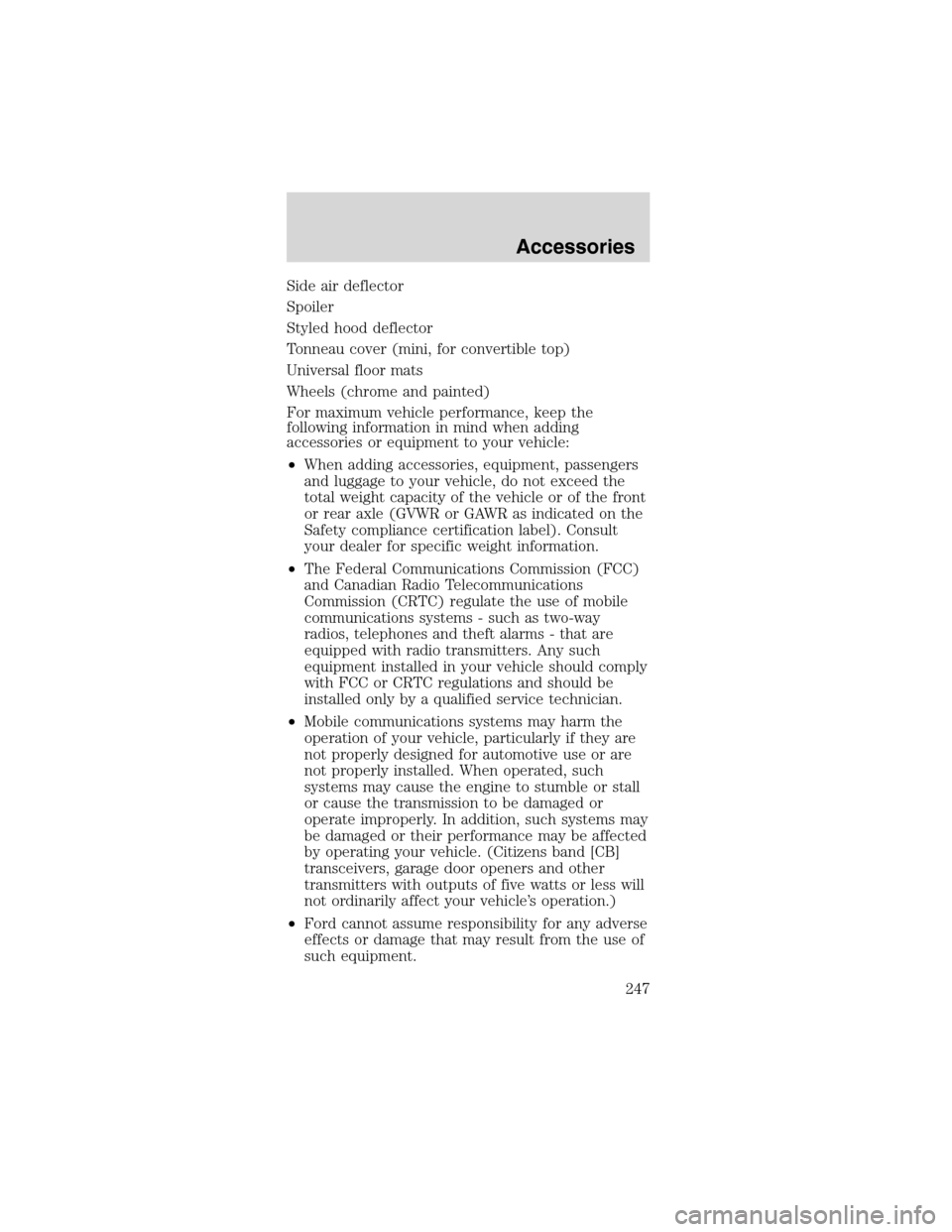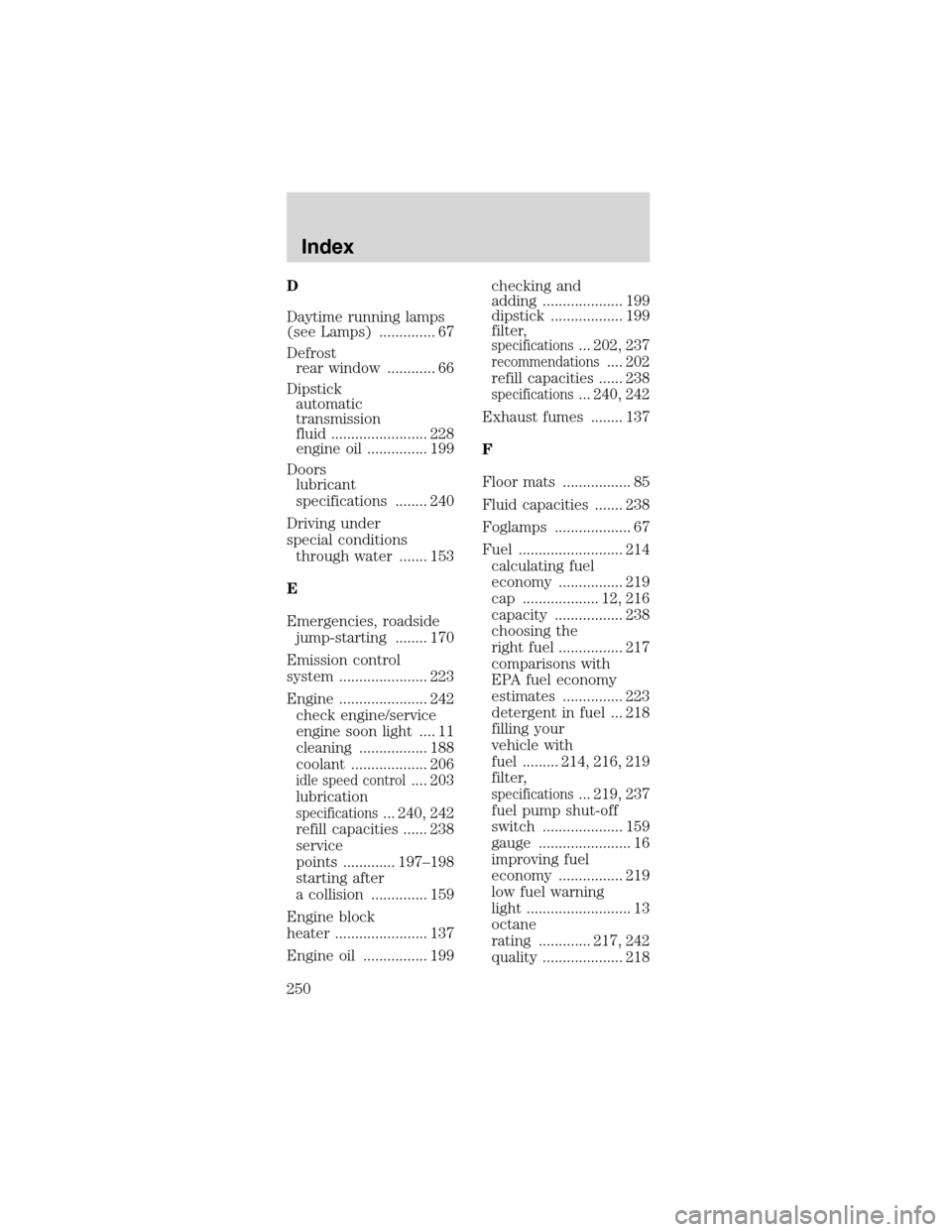2003 FORD MUSTANG adding oil
[x] Cancel search: adding oilPage 201 of 256

•4.6LSOHCV8 engine
•Oil levels above the MAX mark may cause engine
damage. Some oil must be removed from the
engine by a service technician.
7. Put the indicator back in and ensure it is fully
seated.
Adding engine oil
1. Check the engine oil. For instructions, refer to
Checking the engine oilin this chapter.
2. If the engine oil level is not within the normal
range, add only certified engine oil of the
recommended viscosity. Remove the engine oil filler
cap and use a funnel to pour the engine oil into the
opening.
3. Recheck the engine oil level. Make sure the oil
level is not above the MAX mark on the engine oil
level indicator (dipstick).
4. Install the indicator and ensure it is fully seated.
5. Fully install the engine oil filler cap by turning the
filler cap clockwise 1/4 of a turn until three clicks
are heard or until the cap is fully seated.
To avoid possible oil loss, DO NOT operate the
vehicle with the engine oil level indicator
and/or the engine oil filler cap removed.
Maintenance and Specifications
201
Page 206 of 256

ENGINE COOLANT
Checking engine coolant
The concentration and level of engine coolant should
be checked at the mileage intervals in the scheduled
maintenance guide. The coolant concentration
should be maintained at 50/50 coolant and water,
which equates to a freeze point of -36°C (-34°F).
Coolant concentration testing is possible with a
hydrometer or antifreeze tester (such as the
Rotunda Battery and Antifreeze Tester, 014–R1060).
The level of coolant should be maintained at the
“cold full”of“cold fill range”level in the coolant
reservoir. If the level falls below, add coolant per the
instructions in theAdding Engine Coolantsection.
Your vehicle was factory-filled with a 50/50 engine
coolant and water concentration. If the
concentration of coolant falls below 40% or above
60%, the engine parts could become damaged or not
work properly.A50–50 mixture of coolant and
water provides the following:
•freeze protection down to -36°C (-34°F)
•boiling protection up to 129°C (265°F)
•protection against rust and other forms of
corrosion
•enables calibrated gages to function properly
•3.8L OHV V6 engine
Maintenance and Specifications
206
Page 222 of 256

•Using the air conditioner or defroster may reduce
fuel economy.
•You may want to turn off the speed control in
hilly terrain if unnecessary shifting between third
and fourth gear occurs. Unnecessary shifting of
this type could result in reduced fuel economy.
•Warming up a vehicle on cold mornings is not
required and may reduce fuel economy.
•Resting your foot on the brake pedal while driving
may reduce fuel economy.
•Combine errands and minimize stop-and-go
driving.
Maintenance
•Keep tires properly inflated and use only
recommended size.
•Operating a vehicle with the wheels out of
alignment will reduce fuel economy.
•Use recommended engine oil. Refer toLubricant
specificationsin this chapter.
•Perform all regularly scheduled maintenance
items. Follow the recommended maintenance
schedule and owner maintenance checks found in
your vehicle scheduled maintenance guide.
Conditions
•Heavily loading a vehicle or towing a trailer may
reduce fuel economy at any speed.
•Carrying unnecessary weight may reduce fuel
economy (approximately 0.4 km/L [1 mpg] is lost
for every 180 kg [400 lb] of weight carried).
•Adding certain accessories to your vehicle (for
example bug deflectors, rollbars/light bars,
running boards, ski/luggage racks) may reduce
fuel economy.
•Using fuel blended with alcohol may lower fuel
economy.
•Fuel economy may decrease with lower
temperatures during the first 12–16 km (8–10
miles) of driving.
Maintenance and Specifications
222
Page 247 of 256

Sideair deflector
Spoiler
Styled hood deflector
Tonneau cover (mini, for convertible top)
Universal floor mats
Wheels (chrome and painted)
For maximum vehicle performance, keep the
following information in mind when adding
accessories or equipment to your vehicle:
•When adding accessories, equipment, passengers
and luggage to your vehicle, do not exceed the
total weight capacity of the vehicle or of the front
or rear axle (GVWR or GAWR as indicated on the
Safety compliance certification label). Consult
your dealer for specific weight information.
•The Federal Communications Commission (FCC)
and Canadian Radio Telecommunications
Commission (CRTC) regulate the use of mobile
communications systems - such as two-way
radios, telephones and theft alarms - that are
equipped with radio transmitters. Any such
equipment installed in your vehicle should comply
with FCC or CRTC regulations and should be
installed only by a qualified service technician.
•Mobile communications systems may harm the
operation of your vehicle, particularly if they are
not properly designed for automotive use or are
not properly installed. When operated, such
systems may cause the engine to stumble or stall
or cause the transmission to be damaged or
operate improperly. In addition, such systems may
be damaged or their performance may be affected
by operating your vehicle. (Citizens band [CB]
transceivers, garage door openers and other
transmitters with outputs of five watts or less will
not ordinarily affect your vehicle’s operation.)
•Ford cannot assume responsibility for any adverse
effects or damage that may result from the use of
such equipment.
Accessories
247
Page 250 of 256

D
Daytime running lamps
(see Lamps) .............. 67
Defrost
rear window ............ 66
Dipstick
automatic
transmission
fluid ........................ 228
engine oil ............... 199
Doors
lubricant
specifications ........ 240
Driving under
special conditions
through water ....... 153
E
Emergencies, roadside
jump-starting ........ 170
Emission control
system ...................... 223
Engine ...................... 242
check engine/service
engine soon light .... 11
cleaning ................. 188
coolant ................... 206
idle speed control.... 203
lubrication
specifications... 240, 242
refill capacities ...... 238
service
points ............. 197–198
starting after
a collision .............. 159
Engine block
heater ....................... 137
Engine oil ................ 199checking and
adding .................... 199
dipstick .................. 199
filter,
specifications... 202, 237
recommendations.... 202
refill capacities ...... 238
specifications... 240, 242
Exhaust fumes ........ 137
F
Floor mats ................. 85
Fluid capacities ....... 238
Foglamps ................... 67
Fuel .......................... 214
calculating fuel
economy ................ 219
cap ................... 12, 216
capacity ................. 238
choosing the
right fuel ................ 217
comparisons with
EPA fuel economy
estimates ............... 223
detergent in fuel ... 218
filling your
vehicle with
fuel ......... 214, 216, 219
filter,
specifications... 219, 237
fuel pump shut-off
switch .................... 159
gauge ....................... 16
improving fuel
economy ................ 219
low fuel warning
light .......................... 13
octane
rating ............. 217, 242
quality .................... 218
Index
250
Page 253 of 256

Odometer ................... 17
Oil (see
Engine oil) ............... 199
Overdrive ........... 84, 146
P
Panic alarm feature,
remote entry
system ........................ 92
Parking brake .......... 139
Parts (see Motorcraft
parts) ....................... 237
Power distribution
box (see Fuses) ...... 163
Power door locks ...... 89
Power mirrors ........... 80
Power point ............... 78
Power steering ........ 142
fluid, checking
and adding ............ 225
fluid, refill
capacity ................. 238
fluid,
specifications... 240, 242
Power Windows ......... 78
R
Radio .................... 19, 43
Radio reception ... 61–62
Rear window
defroster .................... 66
Relays ...................... 160
Remote entry
system .................. 91–92
illuminated entry .... 94locking/unlocking
doors .................. 89, 92
opening the trunk ... 93
panic alarm ............. 92
replacement/additional
transmitters ............. 94
replacing the
batteries .................. 93
Roadside
assistance ................ 157
S
Safety belts (see
Safety restraints) ..... 14,
102, 104–107
Safety defects,
reporting .................. 186
Safety
restraints... 102, 104–107
belt minder ........... 109
cleaning the
safety belts ............ 113
extension
assembly ................ 113
for adults ....... 104–107
for children ... 119–120
warning light
and chime ............... 10,
14, 108–109
Safety seats
for children .............. 123
Seat belts (see Safety
restraints) ................ 102
Seats .......................... 99
child safety seats .. 123
SecuriLock passive
anti-theft
system .................. 95–97
Index
253